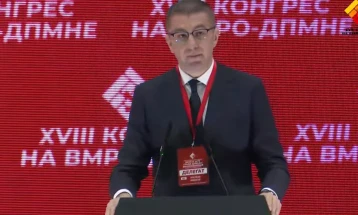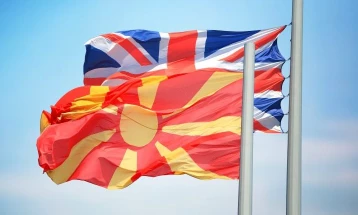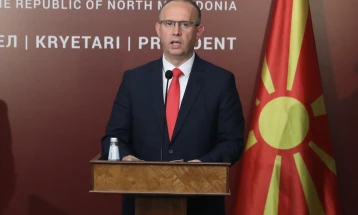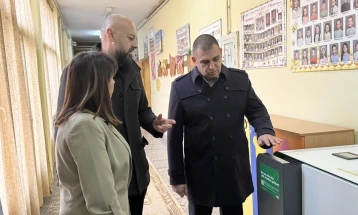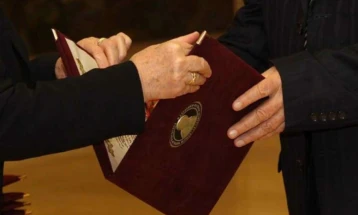Authorities claim to have learned the lesson after 2021 devastating wildfires
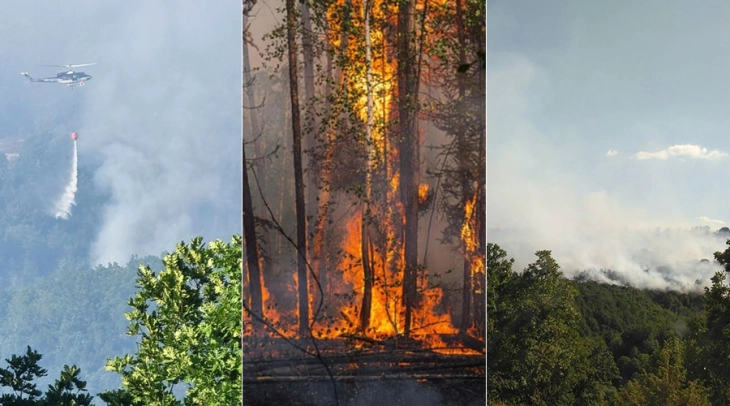
Skopje, 6 August 2022 (MIA) – Every culture has a forest cult, one inspiring admiration and fear, awakening thoughts that the forest has an inexplicable power and force. Last year, on August 2, multiple fires broke out, that according to old wives’ tales, we’re to blame for by “waking up the powers of the forest”. These fires last year were most concentrated in the Maleshevo region, where people lost more things than just the forest. They lost their houses, livestock and bees. This year, new dangers from new fires arise. The authorities, however, claim to have learned their lesson and that they’ve “put the fires under control”.
Climate change is listed as one of the culprits, whilst others believe that they were caused by negligence, outdoor barbecuing, cigarette butts, others claim the fires were caused for economic reasons for cheaper burned wood for processing of pellets, which sell for only MKD 790 per cubic meter, which is quite cost-effective. The National Forests Public Enterprise denies this claim, informing that out of the 390 thousand cubic meters of trees that burned, 150 thousand have been bought from 150 legal subjects and there’s the same amount left to sell.
The police have taken more intensive measures and activities to prevent fires in forests, pastures and other open areas, and due to the increased number of fires last summer, a state of emergency was declared between June 1 and September 30.
The Interior Ministry (MoI) tells MIA that 16 fire reports were made last year in the aforementioned period, and they’re working on uncovering the perpetrators.
Through the Safe Summer campaign, the police have involved the local community in the prevention and more successful management of fires, especially ones outdoors and in forests. The citizens have been handed educational flyers with basic safety tips on forest fire management, as well as telling them to be especially careful not to light fires outside in dry vegetation and pastures, to avoid throwing away cigarette butts, and that way we can contribute to forest preservation, and to keep safe the lives, health, and assets of others and our own. The MoI will continue its fire prevention activities over the upcoming period.
Stojanche Angelov, director of the Crisis Management Center, tells MIA that they’ve learned their lesson from las year’s fires, and that things are excellently controlled for now, as opposed to other Balkan countries. He said that they’re reacting swiftly and professionally, but that the citizens’ safety is their top priority.
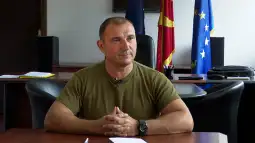 “We’ve faced a few severe fires in April, May and June, and a good part of them happened because of setting fires to stubble or pastures. Things are different now. Vegetation is significantly dried out, there is no rainfall, and the temperatures are extremely high, rising towards 40 C, and these are the key factors that enable quick spreading of fires, and hot winds, which blow frequently, cause an easy spread of the fires and for them to move in different directions and encompass huge areas. Personally, I think we’ve learned our lesson from last year, but we knew it last year as well. The problem is this global climate change which has caused huge fires not just here, but all over the Balkans and Europe,” Angelov said.
Since July, there have been 75 outdoor fires, and over half have been severe. Angelov says that even more organized countries, such as Greece, Turkey, Portugal or Spain, can’t handle these fires. The Slovenians, who helped us last year, are asking for outside help to put out a big fire.
Angelov also says that climate change has done its damage, and we can’t just talk about weaknesses in the country or the crisis management system, because if we compare it to neighboring countries, the region, and Europe, then yes, we may have had a large number of fires here ourselves, lots of material damages, but not a single human life was lost. What comes first is “the citizens’, the firefighters and the pilots’ lives, then the forests, because new trees will grow, but human lives won’t return”.
“We’ve faced a few severe fires in April, May and June, and a good part of them happened because of setting fires to stubble or pastures. Things are different now. Vegetation is significantly dried out, there is no rainfall, and the temperatures are extremely high, rising towards 40 C, and these are the key factors that enable quick spreading of fires, and hot winds, which blow frequently, cause an easy spread of the fires and for them to move in different directions and encompass huge areas. Personally, I think we’ve learned our lesson from last year, but we knew it last year as well. The problem is this global climate change which has caused huge fires not just here, but all over the Balkans and Europe,” Angelov said.
Since July, there have been 75 outdoor fires, and over half have been severe. Angelov says that even more organized countries, such as Greece, Turkey, Portugal or Spain, can’t handle these fires. The Slovenians, who helped us last year, are asking for outside help to put out a big fire.
Angelov also says that climate change has done its damage, and we can’t just talk about weaknesses in the country or the crisis management system, because if we compare it to neighboring countries, the region, and Europe, then yes, we may have had a large number of fires here ourselves, lots of material damages, but not a single human life was lost. What comes first is “the citizens’, the firefighters and the pilots’ lives, then the forests, because new trees will grow, but human lives won’t return”.
 Faulty electrical wiring, deliberate burning of trees to reduce prices, and pyromania – reasons behind the fires
Among the causes of the fires, where human negligence is most commonly observed, fires from electrical lines and power lines and low voltage networks were noted last summer. Wires that are loose in warm weather can stretch further and touch when blowing winds, sparks fly, which fall into dry grass and behind them the grass ignites and the fire spreads.
One common reason, according to Angelov, is the human factor. The reasons, he says, often can be criminal – deliberately burning trees to then buy them foe cheaper or, in turn, certain persons burn forests of pathological motives – arsonists who enjoy fire, not thinking they can kill someone, but there are also fires of carelessness.
“I therefore appeal to citizens not to start fires in the open, not to grill, and even those gas grills and gas appliances can cause large fires at some point, as safe as they are, with a little carelessness they may fall and burn the immediate environment, dry grass or, in an even darker scenario, some evergreen trees where there is good shade to burn dry needles that fall from green trees, cones, etc., which then burn very easily due to resin and the fire spreads at huge speeds,” Angelov said.
He points out that the greatest success is raising public awareness, primarily, as he said, thanks to the media, which keep the topic highly talked about throughout the year, and even in the winter months.
“Thanks to the media, I believe that civil awareness is at a high level. We’re noticing a change in the citizens’ behavior. Like I’ve said, the vast majority of citizens are extremely cautious, there is a small majority of negligent people, even less those who set fires on purpose due to criminal or pathological motives. No matter how minor the reason, it’s enough to cause severe fires, which is where we come in. I also have to commend the MoI and the Protection and Rescue Directorate, and National Forests, and even the national parks which talk about this topic all throughout the year with their own campaigns, appealing to citizens to be extremely careful when moving outdoors,” Angelov said.
He reiterates that about a month ago a partial ban was introduced, according to which any citizen can go to the mountain, but only after previously obtaining a permit from National Forests, if it is a mountain and forest under their jurisdiction. In addition to "National Forests, there are four national parks that issue such permits on their own.
“We, although we do not deny people, still have an insight about what moves in these forests and it makes it easier for us to discover a possible fire starter,” Angelov stressed.
He appeals to citizens to report to the free phone number 112 any suspicious behavior or person moving in the forest or in some way handling a fire in the forest, to report it to the free phone number 112, because early tips are very significant.
One police helicopter, the Protection and Rescue Directorate plane, and two army choppers available this year
Faulty electrical wiring, deliberate burning of trees to reduce prices, and pyromania – reasons behind the fires
Among the causes of the fires, where human negligence is most commonly observed, fires from electrical lines and power lines and low voltage networks were noted last summer. Wires that are loose in warm weather can stretch further and touch when blowing winds, sparks fly, which fall into dry grass and behind them the grass ignites and the fire spreads.
One common reason, according to Angelov, is the human factor. The reasons, he says, often can be criminal – deliberately burning trees to then buy them foe cheaper or, in turn, certain persons burn forests of pathological motives – arsonists who enjoy fire, not thinking they can kill someone, but there are also fires of carelessness.
“I therefore appeal to citizens not to start fires in the open, not to grill, and even those gas grills and gas appliances can cause large fires at some point, as safe as they are, with a little carelessness they may fall and burn the immediate environment, dry grass or, in an even darker scenario, some evergreen trees where there is good shade to burn dry needles that fall from green trees, cones, etc., which then burn very easily due to resin and the fire spreads at huge speeds,” Angelov said.
He points out that the greatest success is raising public awareness, primarily, as he said, thanks to the media, which keep the topic highly talked about throughout the year, and even in the winter months.
“Thanks to the media, I believe that civil awareness is at a high level. We’re noticing a change in the citizens’ behavior. Like I’ve said, the vast majority of citizens are extremely cautious, there is a small majority of negligent people, even less those who set fires on purpose due to criminal or pathological motives. No matter how minor the reason, it’s enough to cause severe fires, which is where we come in. I also have to commend the MoI and the Protection and Rescue Directorate, and National Forests, and even the national parks which talk about this topic all throughout the year with their own campaigns, appealing to citizens to be extremely careful when moving outdoors,” Angelov said.
He reiterates that about a month ago a partial ban was introduced, according to which any citizen can go to the mountain, but only after previously obtaining a permit from National Forests, if it is a mountain and forest under their jurisdiction. In addition to "National Forests, there are four national parks that issue such permits on their own.
“We, although we do not deny people, still have an insight about what moves in these forests and it makes it easier for us to discover a possible fire starter,” Angelov stressed.
He appeals to citizens to report to the free phone number 112 any suspicious behavior or person moving in the forest or in some way handling a fire in the forest, to report it to the free phone number 112, because early tips are very significant.
One police helicopter, the Protection and Rescue Directorate plane, and two army choppers available this year
 There are different ways to alert that a fire has broken out somewhere. Angelov says that the CMC finds out and receives reports relatively quickly. There are also live satellite recordings, which immediately report if there is a major fire, but the pilots of passenger planes also have the obligation to report to Air Traffic Control if they notice a fire.
“But it is a problem if it is located on a mountain in a difficult to access or, I would say, sometimes completely inaccessible place for infantry, for firefighters. Then the only way is the planes, but the helicopters have to be ready to take off, maybe at that moment they are putting out a fire somewhere else or maybe the weather is very hot. The army helicopter has thermal limitations, above 38 degrees it is not safe to fly, such are its technical-tactical characteristics. So, we sometimes have a helicopter, but it is not allowed to take off,” said Angelov.
Airplanes also have limitations, that is, the Directorate’s plane, because it cannot fill with water from anywhere, it needs a larger water surface. There are only a few places in the country that are suitable for in-flight refueling of these aircraft and this reduces their efficiency.
- But precisely for these reasons, this year we are using a new tactic that the Austrians and Slovenians used last year, we already have a pool that we fill close to the fire in a place where there is a river or there is a sufficient amount of water, from which they can fill water, and in this way we shorten the flight time from the place of the fire to the place of filling with water, clarified the director of the Crisis Management Center.
This year, two army helicopters, one police helicopter and one plane of the Protection and Rescue Directorate are available. The second Directorate plane is expected to arrive at any moment, but the delay, as Angelov explains, is due to the lack of a pilot on the part of the company that performs the service.
The plane is under its authority until landing in Skopje. Due to the developments in Europe, they do not have a sufficient number of helicopters and do not fulfill their obligation that they have with the contract, and that is the reason why we still do not have the second plane, says Angelov.
Burnt trees for sale at a bargain price
The Director of PE National Forests, Valentin Gruevski, tells MIA that the company monitors the situation daily, reacts appropriately on the ground and successfully implements the obligation to reforest the burned areas. One year after the biggest fires in recent Macedonian history, a wood mass with a total amount of 390,000 cubic meters on thousands of hectares was burned and a wood mass estimated to be the direct damage caused to "National Forests" of about seven million euros.
There are different ways to alert that a fire has broken out somewhere. Angelov says that the CMC finds out and receives reports relatively quickly. There are also live satellite recordings, which immediately report if there is a major fire, but the pilots of passenger planes also have the obligation to report to Air Traffic Control if they notice a fire.
“But it is a problem if it is located on a mountain in a difficult to access or, I would say, sometimes completely inaccessible place for infantry, for firefighters. Then the only way is the planes, but the helicopters have to be ready to take off, maybe at that moment they are putting out a fire somewhere else or maybe the weather is very hot. The army helicopter has thermal limitations, above 38 degrees it is not safe to fly, such are its technical-tactical characteristics. So, we sometimes have a helicopter, but it is not allowed to take off,” said Angelov.
Airplanes also have limitations, that is, the Directorate’s plane, because it cannot fill with water from anywhere, it needs a larger water surface. There are only a few places in the country that are suitable for in-flight refueling of these aircraft and this reduces their efficiency.
- But precisely for these reasons, this year we are using a new tactic that the Austrians and Slovenians used last year, we already have a pool that we fill close to the fire in a place where there is a river or there is a sufficient amount of water, from which they can fill water, and in this way we shorten the flight time from the place of the fire to the place of filling with water, clarified the director of the Crisis Management Center.
This year, two army helicopters, one police helicopter and one plane of the Protection and Rescue Directorate are available. The second Directorate plane is expected to arrive at any moment, but the delay, as Angelov explains, is due to the lack of a pilot on the part of the company that performs the service.
The plane is under its authority until landing in Skopje. Due to the developments in Europe, they do not have a sufficient number of helicopters and do not fulfill their obligation that they have with the contract, and that is the reason why we still do not have the second plane, says Angelov.
Burnt trees for sale at a bargain price
The Director of PE National Forests, Valentin Gruevski, tells MIA that the company monitors the situation daily, reacts appropriately on the ground and successfully implements the obligation to reforest the burned areas. One year after the biggest fires in recent Macedonian history, a wood mass with a total amount of 390,000 cubic meters on thousands of hectares was burned and a wood mass estimated to be the direct damage caused to "National Forests" of about seven million euros.
 - One year after that, 'National Forests' are actively working on clearing the terrain, because it is a legal obligation to clear that terrain within two years, and then to take other measures such as reforestation so that we can someday, at some point future, let's get the same forest fund. In this part, in this year, we have concluded somewhere around 150 contracts with legal entities for the amount of around 150,000 cubic meters and in those areas, we are actively working on the removal of the burnt wood mass. And I think that during this year and during the next year, we as "National Forests" will clean up that part and complete our legal obligation. Legal entities from the country, which mostly use this wood for pallets and pallet production, are interested, Gruevski says.
He clarifies that it is a matter of wood that is in Maleshevija, black and white pine, which is not used for firewood and that the price, which is MKD 790 per cubic meter, is low due to the fact that the companies themselves take the wood from the forests, so no additional finance expense for the Public Enterprise.
“In accordance with the Law in the country, after the fires in August 2021, the procedure began in which the wood mass was first assessed, how much it was damaged. The marks were received from the State Forestry Inspectorate. And we conducted a transparent procedure in which we announced a public call for all those who are interested in buying that burned wood mass to call the public call. All interested legal entities came forward and showed interest in the two-year period in which we are legally obliged to remove the trees, to remove wood mass in a total amount of 300,000 cubic meters. All interested legal entities have received sections in which they can remove wood mass and it is still open for anyone who is interested, as we have sections that have not yet been given, to come and contract with us, to remove the burnt wood mass. With this I want to say or maybe dispel the speculations that the wooden mass is deliberately set on fire so that someone can buy it,” Gruevski stresses.
"National Forests" has an obligation to reforest the burned areas, but only after the terrain is cleared. According to "National Forests", this year the plan is to afforest about 600-700 hectares of land and to plant about 2.5 thousand seedlings on each hectare. The company informs that they are satisfied with the companies' interest in participating in afforestation and they say that anyone who is interested in National Forests can meet them and deliver seedlings.
- One year after that, 'National Forests' are actively working on clearing the terrain, because it is a legal obligation to clear that terrain within two years, and then to take other measures such as reforestation so that we can someday, at some point future, let's get the same forest fund. In this part, in this year, we have concluded somewhere around 150 contracts with legal entities for the amount of around 150,000 cubic meters and in those areas, we are actively working on the removal of the burnt wood mass. And I think that during this year and during the next year, we as "National Forests" will clean up that part and complete our legal obligation. Legal entities from the country, which mostly use this wood for pallets and pallet production, are interested, Gruevski says.
He clarifies that it is a matter of wood that is in Maleshevija, black and white pine, which is not used for firewood and that the price, which is MKD 790 per cubic meter, is low due to the fact that the companies themselves take the wood from the forests, so no additional finance expense for the Public Enterprise.
“In accordance with the Law in the country, after the fires in August 2021, the procedure began in which the wood mass was first assessed, how much it was damaged. The marks were received from the State Forestry Inspectorate. And we conducted a transparent procedure in which we announced a public call for all those who are interested in buying that burned wood mass to call the public call. All interested legal entities came forward and showed interest in the two-year period in which we are legally obliged to remove the trees, to remove wood mass in a total amount of 300,000 cubic meters. All interested legal entities have received sections in which they can remove wood mass and it is still open for anyone who is interested, as we have sections that have not yet been given, to come and contract with us, to remove the burnt wood mass. With this I want to say or maybe dispel the speculations that the wooden mass is deliberately set on fire so that someone can buy it,” Gruevski stresses.
"National Forests" has an obligation to reforest the burned areas, but only after the terrain is cleared. According to "National Forests", this year the plan is to afforest about 600-700 hectares of land and to plant about 2.5 thousand seedlings on each hectare. The company informs that they are satisfied with the companies' interest in participating in afforestation and they say that anyone who is interested in National Forests can meet them and deliver seedlings.
 Decreased interest in employment in the forestry service
"National Forests" is facing a shortage of forest ranger service, and, as Gruevski tells MIA, there is not much interest in this job position.
The public company is in charge of providing the first response to fires and arriving first at the scene of the fire, the forest ranger service is on the ground nonstop, and there are about 300 forest rangers on the territory of the state.
“It is not a sufficient number, and it is a number that has been decreasing in recent years, given that there are many, I mean not a small number of employees in the PE, but the number of employees has been decreasing in recent years. We have about 400 fewer employees, among whom are many forest rangers who have retired. We have an obligation to be the first to respond to the fire, to notify and at the moment as National Forests we have 19 vehicles that can be used for firefighting. Those vehicles are in good condition and we have a tank which is in the branch office in Kavadarci. These are correct vehicles that can be used when extinguishing the fire. However, citizens should also know that National Forests is not a company that puts out fires, it only needs to react quickly and always, always be at the scene of the incident,” Gruevski emphasizes.
He adds that in addition to vehicles, they are also equipped with hand pumps, and the tender for the purchase of another hundred hand sprinklers is currently ending. He explains that these are sprinklers that collect about 25 liters of water.
"National Forests" believe that the cause of the forest fires is mostly human carelessness and that precisely because of the fact that at this time of the year there is burning of stubble and movement through the forest, as well as inappropriate behavior.
“I think that at this moment there is no consideration for a complete ban on movement in the forests. However, if we assess and our services assess that it should be done, we will submit a proposal to the Ministry of Agriculture, and the minister is the one who approves our proposal or does not adopt our proposal,” says Gruevski.
https://youtu.be/bepypjaaIFg
Boris Kunoski
Photos: MIA archives
Video: Srgjan Krstikj
Translator: Dragana Knezhevikj
Decreased interest in employment in the forestry service
"National Forests" is facing a shortage of forest ranger service, and, as Gruevski tells MIA, there is not much interest in this job position.
The public company is in charge of providing the first response to fires and arriving first at the scene of the fire, the forest ranger service is on the ground nonstop, and there are about 300 forest rangers on the territory of the state.
“It is not a sufficient number, and it is a number that has been decreasing in recent years, given that there are many, I mean not a small number of employees in the PE, but the number of employees has been decreasing in recent years. We have about 400 fewer employees, among whom are many forest rangers who have retired. We have an obligation to be the first to respond to the fire, to notify and at the moment as National Forests we have 19 vehicles that can be used for firefighting. Those vehicles are in good condition and we have a tank which is in the branch office in Kavadarci. These are correct vehicles that can be used when extinguishing the fire. However, citizens should also know that National Forests is not a company that puts out fires, it only needs to react quickly and always, always be at the scene of the incident,” Gruevski emphasizes.
He adds that in addition to vehicles, they are also equipped with hand pumps, and the tender for the purchase of another hundred hand sprinklers is currently ending. He explains that these are sprinklers that collect about 25 liters of water.
"National Forests" believe that the cause of the forest fires is mostly human carelessness and that precisely because of the fact that at this time of the year there is burning of stubble and movement through the forest, as well as inappropriate behavior.
“I think that at this moment there is no consideration for a complete ban on movement in the forests. However, if we assess and our services assess that it should be done, we will submit a proposal to the Ministry of Agriculture, and the minister is the one who approves our proposal or does not adopt our proposal,” says Gruevski.
https://youtu.be/bepypjaaIFg
Boris Kunoski
Photos: MIA archives
Video: Srgjan Krstikj
Translator: Dragana Knezhevikj
 “We’ve faced a few severe fires in April, May and June, and a good part of them happened because of setting fires to stubble or pastures. Things are different now. Vegetation is significantly dried out, there is no rainfall, and the temperatures are extremely high, rising towards 40 C, and these are the key factors that enable quick spreading of fires, and hot winds, which blow frequently, cause an easy spread of the fires and for them to move in different directions and encompass huge areas. Personally, I think we’ve learned our lesson from last year, but we knew it last year as well. The problem is this global climate change which has caused huge fires not just here, but all over the Balkans and Europe,” Angelov said.
Since July, there have been 75 outdoor fires, and over half have been severe. Angelov says that even more organized countries, such as Greece, Turkey, Portugal or Spain, can’t handle these fires. The Slovenians, who helped us last year, are asking for outside help to put out a big fire.
Angelov also says that climate change has done its damage, and we can’t just talk about weaknesses in the country or the crisis management system, because if we compare it to neighboring countries, the region, and Europe, then yes, we may have had a large number of fires here ourselves, lots of material damages, but not a single human life was lost. What comes first is “the citizens’, the firefighters and the pilots’ lives, then the forests, because new trees will grow, but human lives won’t return”.
“We’ve faced a few severe fires in April, May and June, and a good part of them happened because of setting fires to stubble or pastures. Things are different now. Vegetation is significantly dried out, there is no rainfall, and the temperatures are extremely high, rising towards 40 C, and these are the key factors that enable quick spreading of fires, and hot winds, which blow frequently, cause an easy spread of the fires and for them to move in different directions and encompass huge areas. Personally, I think we’ve learned our lesson from last year, but we knew it last year as well. The problem is this global climate change which has caused huge fires not just here, but all over the Balkans and Europe,” Angelov said.
Since July, there have been 75 outdoor fires, and over half have been severe. Angelov says that even more organized countries, such as Greece, Turkey, Portugal or Spain, can’t handle these fires. The Slovenians, who helped us last year, are asking for outside help to put out a big fire.
Angelov also says that climate change has done its damage, and we can’t just talk about weaknesses in the country or the crisis management system, because if we compare it to neighboring countries, the region, and Europe, then yes, we may have had a large number of fires here ourselves, lots of material damages, but not a single human life was lost. What comes first is “the citizens’, the firefighters and the pilots’ lives, then the forests, because new trees will grow, but human lives won’t return”.
 Faulty electrical wiring, deliberate burning of trees to reduce prices, and pyromania – reasons behind the fires
Among the causes of the fires, where human negligence is most commonly observed, fires from electrical lines and power lines and low voltage networks were noted last summer. Wires that are loose in warm weather can stretch further and touch when blowing winds, sparks fly, which fall into dry grass and behind them the grass ignites and the fire spreads.
One common reason, according to Angelov, is the human factor. The reasons, he says, often can be criminal – deliberately burning trees to then buy them foe cheaper or, in turn, certain persons burn forests of pathological motives – arsonists who enjoy fire, not thinking they can kill someone, but there are also fires of carelessness.
“I therefore appeal to citizens not to start fires in the open, not to grill, and even those gas grills and gas appliances can cause large fires at some point, as safe as they are, with a little carelessness they may fall and burn the immediate environment, dry grass or, in an even darker scenario, some evergreen trees where there is good shade to burn dry needles that fall from green trees, cones, etc., which then burn very easily due to resin and the fire spreads at huge speeds,” Angelov said.
He points out that the greatest success is raising public awareness, primarily, as he said, thanks to the media, which keep the topic highly talked about throughout the year, and even in the winter months.
“Thanks to the media, I believe that civil awareness is at a high level. We’re noticing a change in the citizens’ behavior. Like I’ve said, the vast majority of citizens are extremely cautious, there is a small majority of negligent people, even less those who set fires on purpose due to criminal or pathological motives. No matter how minor the reason, it’s enough to cause severe fires, which is where we come in. I also have to commend the MoI and the Protection and Rescue Directorate, and National Forests, and even the national parks which talk about this topic all throughout the year with their own campaigns, appealing to citizens to be extremely careful when moving outdoors,” Angelov said.
He reiterates that about a month ago a partial ban was introduced, according to which any citizen can go to the mountain, but only after previously obtaining a permit from National Forests, if it is a mountain and forest under their jurisdiction. In addition to "National Forests, there are four national parks that issue such permits on their own.
“We, although we do not deny people, still have an insight about what moves in these forests and it makes it easier for us to discover a possible fire starter,” Angelov stressed.
He appeals to citizens to report to the free phone number 112 any suspicious behavior or person moving in the forest or in some way handling a fire in the forest, to report it to the free phone number 112, because early tips are very significant.
One police helicopter, the Protection and Rescue Directorate plane, and two army choppers available this year
Faulty electrical wiring, deliberate burning of trees to reduce prices, and pyromania – reasons behind the fires
Among the causes of the fires, where human negligence is most commonly observed, fires from electrical lines and power lines and low voltage networks were noted last summer. Wires that are loose in warm weather can stretch further and touch when blowing winds, sparks fly, which fall into dry grass and behind them the grass ignites and the fire spreads.
One common reason, according to Angelov, is the human factor. The reasons, he says, often can be criminal – deliberately burning trees to then buy them foe cheaper or, in turn, certain persons burn forests of pathological motives – arsonists who enjoy fire, not thinking they can kill someone, but there are also fires of carelessness.
“I therefore appeal to citizens not to start fires in the open, not to grill, and even those gas grills and gas appliances can cause large fires at some point, as safe as they are, with a little carelessness they may fall and burn the immediate environment, dry grass or, in an even darker scenario, some evergreen trees where there is good shade to burn dry needles that fall from green trees, cones, etc., which then burn very easily due to resin and the fire spreads at huge speeds,” Angelov said.
He points out that the greatest success is raising public awareness, primarily, as he said, thanks to the media, which keep the topic highly talked about throughout the year, and even in the winter months.
“Thanks to the media, I believe that civil awareness is at a high level. We’re noticing a change in the citizens’ behavior. Like I’ve said, the vast majority of citizens are extremely cautious, there is a small majority of negligent people, even less those who set fires on purpose due to criminal or pathological motives. No matter how minor the reason, it’s enough to cause severe fires, which is where we come in. I also have to commend the MoI and the Protection and Rescue Directorate, and National Forests, and even the national parks which talk about this topic all throughout the year with their own campaigns, appealing to citizens to be extremely careful when moving outdoors,” Angelov said.
He reiterates that about a month ago a partial ban was introduced, according to which any citizen can go to the mountain, but only after previously obtaining a permit from National Forests, if it is a mountain and forest under their jurisdiction. In addition to "National Forests, there are four national parks that issue such permits on their own.
“We, although we do not deny people, still have an insight about what moves in these forests and it makes it easier for us to discover a possible fire starter,” Angelov stressed.
He appeals to citizens to report to the free phone number 112 any suspicious behavior or person moving in the forest or in some way handling a fire in the forest, to report it to the free phone number 112, because early tips are very significant.
One police helicopter, the Protection and Rescue Directorate plane, and two army choppers available this year
 There are different ways to alert that a fire has broken out somewhere. Angelov says that the CMC finds out and receives reports relatively quickly. There are also live satellite recordings, which immediately report if there is a major fire, but the pilots of passenger planes also have the obligation to report to Air Traffic Control if they notice a fire.
“But it is a problem if it is located on a mountain in a difficult to access or, I would say, sometimes completely inaccessible place for infantry, for firefighters. Then the only way is the planes, but the helicopters have to be ready to take off, maybe at that moment they are putting out a fire somewhere else or maybe the weather is very hot. The army helicopter has thermal limitations, above 38 degrees it is not safe to fly, such are its technical-tactical characteristics. So, we sometimes have a helicopter, but it is not allowed to take off,” said Angelov.
Airplanes also have limitations, that is, the Directorate’s plane, because it cannot fill with water from anywhere, it needs a larger water surface. There are only a few places in the country that are suitable for in-flight refueling of these aircraft and this reduces their efficiency.
- But precisely for these reasons, this year we are using a new tactic that the Austrians and Slovenians used last year, we already have a pool that we fill close to the fire in a place where there is a river or there is a sufficient amount of water, from which they can fill water, and in this way we shorten the flight time from the place of the fire to the place of filling with water, clarified the director of the Crisis Management Center.
This year, two army helicopters, one police helicopter and one plane of the Protection and Rescue Directorate are available. The second Directorate plane is expected to arrive at any moment, but the delay, as Angelov explains, is due to the lack of a pilot on the part of the company that performs the service.
The plane is under its authority until landing in Skopje. Due to the developments in Europe, they do not have a sufficient number of helicopters and do not fulfill their obligation that they have with the contract, and that is the reason why we still do not have the second plane, says Angelov.
Burnt trees for sale at a bargain price
The Director of PE National Forests, Valentin Gruevski, tells MIA that the company monitors the situation daily, reacts appropriately on the ground and successfully implements the obligation to reforest the burned areas. One year after the biggest fires in recent Macedonian history, a wood mass with a total amount of 390,000 cubic meters on thousands of hectares was burned and a wood mass estimated to be the direct damage caused to "National Forests" of about seven million euros.
There are different ways to alert that a fire has broken out somewhere. Angelov says that the CMC finds out and receives reports relatively quickly. There are also live satellite recordings, which immediately report if there is a major fire, but the pilots of passenger planes also have the obligation to report to Air Traffic Control if they notice a fire.
“But it is a problem if it is located on a mountain in a difficult to access or, I would say, sometimes completely inaccessible place for infantry, for firefighters. Then the only way is the planes, but the helicopters have to be ready to take off, maybe at that moment they are putting out a fire somewhere else or maybe the weather is very hot. The army helicopter has thermal limitations, above 38 degrees it is not safe to fly, such are its technical-tactical characteristics. So, we sometimes have a helicopter, but it is not allowed to take off,” said Angelov.
Airplanes also have limitations, that is, the Directorate’s plane, because it cannot fill with water from anywhere, it needs a larger water surface. There are only a few places in the country that are suitable for in-flight refueling of these aircraft and this reduces their efficiency.
- But precisely for these reasons, this year we are using a new tactic that the Austrians and Slovenians used last year, we already have a pool that we fill close to the fire in a place where there is a river or there is a sufficient amount of water, from which they can fill water, and in this way we shorten the flight time from the place of the fire to the place of filling with water, clarified the director of the Crisis Management Center.
This year, two army helicopters, one police helicopter and one plane of the Protection and Rescue Directorate are available. The second Directorate plane is expected to arrive at any moment, but the delay, as Angelov explains, is due to the lack of a pilot on the part of the company that performs the service.
The plane is under its authority until landing in Skopje. Due to the developments in Europe, they do not have a sufficient number of helicopters and do not fulfill their obligation that they have with the contract, and that is the reason why we still do not have the second plane, says Angelov.
Burnt trees for sale at a bargain price
The Director of PE National Forests, Valentin Gruevski, tells MIA that the company monitors the situation daily, reacts appropriately on the ground and successfully implements the obligation to reforest the burned areas. One year after the biggest fires in recent Macedonian history, a wood mass with a total amount of 390,000 cubic meters on thousands of hectares was burned and a wood mass estimated to be the direct damage caused to "National Forests" of about seven million euros.
 - One year after that, 'National Forests' are actively working on clearing the terrain, because it is a legal obligation to clear that terrain within two years, and then to take other measures such as reforestation so that we can someday, at some point future, let's get the same forest fund. In this part, in this year, we have concluded somewhere around 150 contracts with legal entities for the amount of around 150,000 cubic meters and in those areas, we are actively working on the removal of the burnt wood mass. And I think that during this year and during the next year, we as "National Forests" will clean up that part and complete our legal obligation. Legal entities from the country, which mostly use this wood for pallets and pallet production, are interested, Gruevski says.
He clarifies that it is a matter of wood that is in Maleshevija, black and white pine, which is not used for firewood and that the price, which is MKD 790 per cubic meter, is low due to the fact that the companies themselves take the wood from the forests, so no additional finance expense for the Public Enterprise.
“In accordance with the Law in the country, after the fires in August 2021, the procedure began in which the wood mass was first assessed, how much it was damaged. The marks were received from the State Forestry Inspectorate. And we conducted a transparent procedure in which we announced a public call for all those who are interested in buying that burned wood mass to call the public call. All interested legal entities came forward and showed interest in the two-year period in which we are legally obliged to remove the trees, to remove wood mass in a total amount of 300,000 cubic meters. All interested legal entities have received sections in which they can remove wood mass and it is still open for anyone who is interested, as we have sections that have not yet been given, to come and contract with us, to remove the burnt wood mass. With this I want to say or maybe dispel the speculations that the wooden mass is deliberately set on fire so that someone can buy it,” Gruevski stresses.
"National Forests" has an obligation to reforest the burned areas, but only after the terrain is cleared. According to "National Forests", this year the plan is to afforest about 600-700 hectares of land and to plant about 2.5 thousand seedlings on each hectare. The company informs that they are satisfied with the companies' interest in participating in afforestation and they say that anyone who is interested in National Forests can meet them and deliver seedlings.
- One year after that, 'National Forests' are actively working on clearing the terrain, because it is a legal obligation to clear that terrain within two years, and then to take other measures such as reforestation so that we can someday, at some point future, let's get the same forest fund. In this part, in this year, we have concluded somewhere around 150 contracts with legal entities for the amount of around 150,000 cubic meters and in those areas, we are actively working on the removal of the burnt wood mass. And I think that during this year and during the next year, we as "National Forests" will clean up that part and complete our legal obligation. Legal entities from the country, which mostly use this wood for pallets and pallet production, are interested, Gruevski says.
He clarifies that it is a matter of wood that is in Maleshevija, black and white pine, which is not used for firewood and that the price, which is MKD 790 per cubic meter, is low due to the fact that the companies themselves take the wood from the forests, so no additional finance expense for the Public Enterprise.
“In accordance with the Law in the country, after the fires in August 2021, the procedure began in which the wood mass was first assessed, how much it was damaged. The marks were received from the State Forestry Inspectorate. And we conducted a transparent procedure in which we announced a public call for all those who are interested in buying that burned wood mass to call the public call. All interested legal entities came forward and showed interest in the two-year period in which we are legally obliged to remove the trees, to remove wood mass in a total amount of 300,000 cubic meters. All interested legal entities have received sections in which they can remove wood mass and it is still open for anyone who is interested, as we have sections that have not yet been given, to come and contract with us, to remove the burnt wood mass. With this I want to say or maybe dispel the speculations that the wooden mass is deliberately set on fire so that someone can buy it,” Gruevski stresses.
"National Forests" has an obligation to reforest the burned areas, but only after the terrain is cleared. According to "National Forests", this year the plan is to afforest about 600-700 hectares of land and to plant about 2.5 thousand seedlings on each hectare. The company informs that they are satisfied with the companies' interest in participating in afforestation and they say that anyone who is interested in National Forests can meet them and deliver seedlings.
 Decreased interest in employment in the forestry service
"National Forests" is facing a shortage of forest ranger service, and, as Gruevski tells MIA, there is not much interest in this job position.
The public company is in charge of providing the first response to fires and arriving first at the scene of the fire, the forest ranger service is on the ground nonstop, and there are about 300 forest rangers on the territory of the state.
“It is not a sufficient number, and it is a number that has been decreasing in recent years, given that there are many, I mean not a small number of employees in the PE, but the number of employees has been decreasing in recent years. We have about 400 fewer employees, among whom are many forest rangers who have retired. We have an obligation to be the first to respond to the fire, to notify and at the moment as National Forests we have 19 vehicles that can be used for firefighting. Those vehicles are in good condition and we have a tank which is in the branch office in Kavadarci. These are correct vehicles that can be used when extinguishing the fire. However, citizens should also know that National Forests is not a company that puts out fires, it only needs to react quickly and always, always be at the scene of the incident,” Gruevski emphasizes.
He adds that in addition to vehicles, they are also equipped with hand pumps, and the tender for the purchase of another hundred hand sprinklers is currently ending. He explains that these are sprinklers that collect about 25 liters of water.
"National Forests" believe that the cause of the forest fires is mostly human carelessness and that precisely because of the fact that at this time of the year there is burning of stubble and movement through the forest, as well as inappropriate behavior.
“I think that at this moment there is no consideration for a complete ban on movement in the forests. However, if we assess and our services assess that it should be done, we will submit a proposal to the Ministry of Agriculture, and the minister is the one who approves our proposal or does not adopt our proposal,” says Gruevski.
https://youtu.be/bepypjaaIFg
Boris Kunoski
Photos: MIA archives
Video: Srgjan Krstikj
Translator: Dragana Knezhevikj
Decreased interest in employment in the forestry service
"National Forests" is facing a shortage of forest ranger service, and, as Gruevski tells MIA, there is not much interest in this job position.
The public company is in charge of providing the first response to fires and arriving first at the scene of the fire, the forest ranger service is on the ground nonstop, and there are about 300 forest rangers on the territory of the state.
“It is not a sufficient number, and it is a number that has been decreasing in recent years, given that there are many, I mean not a small number of employees in the PE, but the number of employees has been decreasing in recent years. We have about 400 fewer employees, among whom are many forest rangers who have retired. We have an obligation to be the first to respond to the fire, to notify and at the moment as National Forests we have 19 vehicles that can be used for firefighting. Those vehicles are in good condition and we have a tank which is in the branch office in Kavadarci. These are correct vehicles that can be used when extinguishing the fire. However, citizens should also know that National Forests is not a company that puts out fires, it only needs to react quickly and always, always be at the scene of the incident,” Gruevski emphasizes.
He adds that in addition to vehicles, they are also equipped with hand pumps, and the tender for the purchase of another hundred hand sprinklers is currently ending. He explains that these are sprinklers that collect about 25 liters of water.
"National Forests" believe that the cause of the forest fires is mostly human carelessness and that precisely because of the fact that at this time of the year there is burning of stubble and movement through the forest, as well as inappropriate behavior.
“I think that at this moment there is no consideration for a complete ban on movement in the forests. However, if we assess and our services assess that it should be done, we will submit a proposal to the Ministry of Agriculture, and the minister is the one who approves our proposal or does not adopt our proposal,” says Gruevski.
https://youtu.be/bepypjaaIFg
Boris Kunoski
Photos: MIA archives
Video: Srgjan Krstikj
Translator: Dragana Knezhevikj 